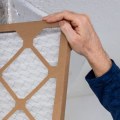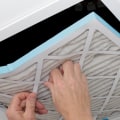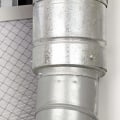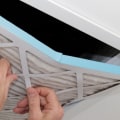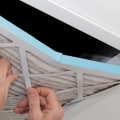While airflows within a particular space can help spread disease among people in that space, there is no definitive evidence to date that a viable virus has been transmitted through an air conditioning system that results in transmission of the disease to people in other spaces serviced by the same system. Because COVID-19 is transmitted through contact with respiratory fluids that carry the infectious SARS-CoV-2 virus, an infected person can be exposed by coughing or talking near them. They can also be exposed by inhaling aerosol particles that spread away from the infected person. Airborne transmission of COVID-19 can occur over distances greater than six feet.
Particles from an infected person can move around an entire room or interior space. Particles can also remain in the air after a person has left the room; in some cases, they can stay in the air for hours. A person can also be exposed through splashes and aerosols of respiratory fluids directly on the mucous membranes. Spread can also sometimes occur through contact with contaminated surfaces, although this route is now considered to be less likely. See scientific and technical resources related to indoor air and coronavirus (COVID-19) or indoor air and key COVID-19 publications for technical information.
There are simple steps that can be taken to reduce the possibility of airborne transmission of COVID-19 and this material focuses on those measures. The layout and design of a building, as well as the occupancy and type of heating, ventilation and air conditioning (HVAC) system, can affect the possible spread of the virus through the air. While improvements in ventilation and air cleanliness alone cannot eliminate the risk of airborne transmission of the SARS-CoV-2 virus, the EPA recommends increasing ventilation with outdoor air and air filtration as important components of a broader strategy that may include physical distancing and the use of cloth face masks or face coverings, surface cleaning, hand washing and other precautions. See guidance from the Centers for Disease Control and Prevention (CDC) and local authorities on current guidelines on mask use. Researchers are investigating how long coronavirus can survive on various surfaces.
The New England Journal of Medicine found that, under laboratory conditions, the virus is “viable up to 72 hours in plastics, 48 hours in stainless steel, 24 hours in cardboard and 4 hours in copper. The researchers found that 72 hours after contamination, the amount of viral material detected on these surfaces is less than 0.1% of the original amount. To be clear, this is only a concern in shared public places. At home, the risk of contracting COVID-19 through drafts or air conditioning units is no more likely to spread the virus through close contact or touching contaminated surfaces. Replacing a ducted HVAC system with a ductless heat pump is one way to prevent the transmission of coronavirus particles through air ducts.
Although minisplit HVAC systems don't bring in fresh air from outside and recirculate indoor air, they don't do so in the same way that ducted systems do. If someone in the room is infected with COVID-19, then they are exhaling the virus, which can remain in airborne droplets and be inhaled by someone else, which could cause an infection. There are only a few published studies analyzing this topic, and experts admit that very little research has been done on the role of HVAC systems in the spread of the novel coronavirus. In fact, other infectious diseases such as measles, tuberculosis, chicken pox, influenza, smallpox and SARS have been shown to spread through heating, ventilation and air conditioning systems. Scientists say very little research has been done on the role of heating, ventilation and air conditioning systems in the spread of coronavirus. Indoors, very fine droplets and particles will continue to spread through the air in the room or space and may accumulate.
Then there is the transmission of aerosols when an infected person expels microscopic infectious particles so small that they remain in the air and spread from person to person in air currents. As an expert SEO I have researched this topic thoroughly to provide you with all you need to know about whether Covid-19 can spread through HVAC systems or not. The answer is not definitive yet but there are certain steps you can take to reduce your risk of exposure to Covid-19 particles through your HVAC system. The most important thing you can do is increase ventilation with outdoor air and use an effective filtration system for your HVAC system. This will help reduce airborne transmission of Covid-19 particles within your home or office space.
Additionally, it's important to follow all guidelines from local authorities regarding mask use as well as practice good hygiene habits such as hand washing. Replacing your ducted HVAC system with a ductless heat pump is another way to reduce your risk of exposure to Covid-19 particles through your HVAC system. Ductless heat pumps don't bring fresh air from outside but they don't recirculate indoor air like ducted systems do either. Finally, it's important to remember that while there is still much research to be done on this topic it's best to take all necessary precautions when it comes to protecting yourself from Covid-19 particles.

